#malevolent john aesthetic
Text









Shitty John Doe aesthetic: it's me arthur i'm the eldritch entity speaking to you from inside your brain. LISTEN TO ME ARTHUR leave arkham now, we don't need it. COME WITH ME ARTHUR and solve these mysteries. we'll have private detective times in... pits, mostly, for some statistically significant reason. doo doo de doo YESSSS ARTHUR. YOU NEED ME ARTHUR OUR FREE WILL IS NOT AN ILLUSION
#john doe#malevolent#john doe malevolent#john malevolent#malevolent podcast#malevolent john#john doe aesthetic#malevolent aesthetic#john doe malevolent aesthetic#john malevolent aesthetic#malevolent podcast aesthetic#malevolent john aesthetic#john doe kin#malevolent kin#john doe malevolent kin#john malevolent kin#malevolent podcast kin#malevolent john kin#shitty aesthetic tm
337 notes
·
View notes
Text
comic#1 of my malevolent p.i au
a domestic sketch #1 if you want something less violent
comic#2(john gets a present)
comicstrip#1(client pov)




this is basically my first try to make a comic so don’t judge me. i did my best 🤷♂️
#art#fanart#illustration#malevolent#character art#digital arwork#arthur lester#john doe#john malevolent#john doe malevolent#jarthur#maybe?#comic#comic art#gg my art#gg my post#malevolent p.i. au#tw: blood#tw violence#red aesthetic#malevolent fanart#arthur malevolent#malevolent john#malevolent podcast#hey… did you perhaps catched the wanted poster on the newspaper..?
1K notes
·
View notes
Text
John: Arthur, I'm begging you please
Arthur, face full of Mr Foust:

65 notes
·
View notes
Text

A flawed fable.
#I'm finishing relistening to s1 and wanted to capture the vibes#i think I'll do this for every season ehe#malevolent#malevolent podcast#aesthetic#arthur lester#john doe#john doe malevolent#this is a romantic jarthur blog btw#proship#<- for containment reasons#my edits#I've tried to squeeze in as many details as possible uhhh#i love making theseeeeee
48 notes
·
View notes
Text






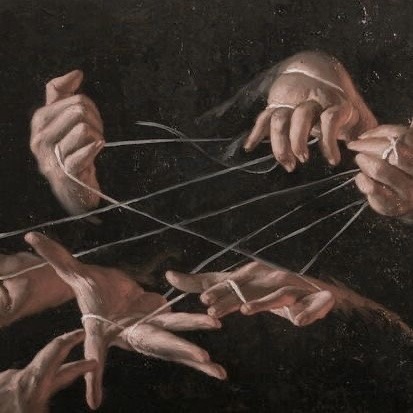

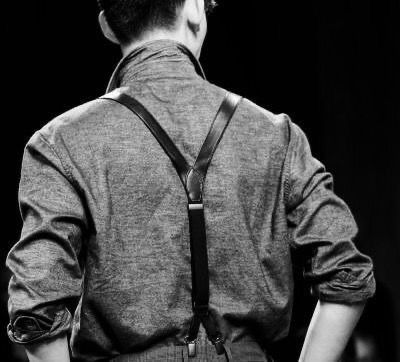
malevolent moodboard
credits
unknown • fraisesrouge • William Richards Castle Jr, 1921, Philip de László (Hungarian, 1869-1937) • unknown • Eye • love is the aim • La mano destra che sa cosa fa la sinistra, giovanni gasparro 2011 • unknown • Bottega Veneta Fall 2015
#guys i had a fucking breakdown trying to find these sources#I AM BEGGING YOU GIVE CREDIT IF YOU POST SOMETHING ON PINTEREST#anyways#happy 3 years to the concept of malevolent :)#malevolent#malevolent pod#malevolent podcast#malevolent moodboard#arthur lester#john doe#john doe malevolent#kayne malevolent#larson malevolent#yellow malevolent#king in yellow#malevolent aesthetics
151 notes
·
View notes
Text

"Where am I? What’s happened?"
"Don’t you remember?"
"Who are you?"
"Who am I? I’m a friend. The best friend you have right now…the only friend you have right now."
- Malevolent podcast
92 notes
·
View notes
Text
oh. and a piece i started to paint back in October. i let it be as it is now. not an Illustration, again, but it takes roots in ep7 i think. cold water, lost control, shock. less scars *sigh*
and a beautiful moon eye that was looking into my window, that absolutely royal, honey, insanely bright yellow hue.
"ARTHUR, BREATHE"
...we all need this line to be voiced inside our skulls sometimes, right?
also play Catch My Heart by Bohren & Der Club of Gore and cry a lot.

(ID in the alt text)
#k's art#arthur lester#john doe malevolent#malevolent podcast#malevolent episode 7#not spoilers actually#visionary#sing for me#aesthetic attraction is still a thing#Gefühlsmaschine#i wonder if i stop looking at his face here like <33333 in a few days#the jester team#the ID ahem turned out sort of... poetic maybe#but it sounds better in my first language (which i won't speak here.)
32 notes
·
View notes
Text
G'morning.
My heart is in pieces thanks to the mess of a private investigator and his ( late??) Eldritch husband.

#malevolent podcast#malevolent spoilers#malevolent brainrot#My eyes are puffy lol#sleep deprived to match Arthur's aesthetics#good God#I dun wanna start the next season without John#*lays on the floor*
7 notes
·
View notes
Text
Malevolent reads like a DnD campaign but there’s only one player, that being Arthur, while Entity and the rest of the people are voiced by the dm.
Example in part 4:
Player: okay, I walk up to the trucker
Dm: okay. Ignoring the vehement protests of the Entity, you walk up to the trucker.
Player: “Excuse me, sir. I’m so sorry to bother you but I was wondering if I could get a ride.”
Dm: before the trucker answers, the Entity interjects, “Arthur! You went to the wrong truck. This one just pulled up. It doesn’t have any signs on it.”
Player: *excuse me*, what do you mean that’s the wrong truck?!
Dm: *well* I’m not the one who walks up to random trucks!
#malevolent#malevolent part 4#yes I know his name is John but it’s for the *aesthetic*#text post#spoiled wine#takes a tumble
13 notes
·
View notes
Text
Yes. I finally started listening to malevolent
So here's some art to celebrate that!!

I love it so much already arghhh the aesthetic, the characters, everything!! It took me so long (and oh boy so many people were begging me to, but I was too far deep hyperfixated on TMA to even try. But now is time) I want malevolent moots 🫵🏻 No spoils please I'll try to be up to date as fast as I can
Here's some silly comics I made :



Also It's hilarious how non self aware Arthur is about speaking out loud to a voice in his head (those taxi drivers have HEARD things)
And to all of those people who only draw John and Arthur smiling and picking up flowers in a cute little garden with butterflies y'all are insane/j
Fr tho, I want more people to draw Arthur and John in their actual setting because y'all, vintage is so cool I'm begging literally
I was NOT ready for how chaotic this was nor for their personalities
Variants :



#arthur lester malevolent#malevolent podcast#malevolent fanart#malevolent#arthur lester#john doe#john malevolent#art#digital art#artists on tumblr
169 notes
·
View notes
Text
Redoing my pinned post!
Heyo!! Call me Mars or Aster, i use he/hymn/it pronouns, and this is my main blog for all things! I'm alterhuman and queer in almost every way possible, and this is my place to be obnoxious about it. I’m also autistic and vocal about it. That’s the summary, more info below the cut!!
About Me
Alterhuman things
Kintype(s): Western dragon; fallen angel/demon; nökk/nixie/nokken
Theriotype(s): Maned wolf (linktype)
Theriomythic type(s): Night (or Forest??) Fury (linktype)
Fictionflicker type(s): Eztli Tokoyami (MHA/BNHA, non-canon); Rust (TMA, non-canon Corruption avatar); the Leviathan (TMA, non-canon Hunt/Vast avatar); Mike Crew (TMA); MK (Lego Monkie Kid); John Doe (Malevolent)
Hearthome(s): Star Trek
Hearttype(s): changelings; canines; space/stars
Archetrope(s): Guardian
Satellotype(s): Harpy eagle (orbiting the Leviathan); red winged blackbird (orbiting Eztli); felines (orbiting both of my dragon kintypes)
Miscecanis/miscanimalis: Beta, scent is ozone and old books with an undercurrent of sandalwood, revolves around all of my alterhumanity but specifically avian, canine, and eldritch behaviors
Queer Things
The short answer for my gender is multigender boy+ butch bear freakthingcreature, the long answer is ‘i dont know if i have a gender, i dont know what a gender is supposed to feel like, but i like being referred to with masculine terms and also there are things that are intrinsically important to my identity so i might as well call them genders’
Xenohoarder, here’s my hoard: https://docs.google.com/document/d/1_P8tza81UckHbBm2LaRa_mzihvhPHPq_kNIDICQpAY8/edit?usp=sharing
The label i usually use for my orientation is omni, but the long and short of it is i like men in a fag way and women in a dyke way and men in a dyke way and women in a fag way and absolutely everyone in a queer way
Aroacespec, demirose
Name and pronoun hoarder, my pronoun page is here: https://en.pronouns.page/@fallen-and-holy
Objectum, mostly aesthetic attraction to things like computers but very much in love with the moon, the sea, space, and pretty much the concept of the Vast
Misc
quick guide to the first person pronouns I use: i/me/mine/myself refers to me and sometimes my subsystem; eye/me/meye/meyeself refers to just me; wei/muis/muir/muirself refers to me and my subsystem and sometimes my dæmon; we/us/ours/ourself refers to me and Cypher.
Plural, not sure how much im going to talk about that on here. Im a median subsystem with a dæmon as well as having one headmate, Cypher.
I dont really have a DNI, because those dont work and people are going to do what they want, but you will be blocked if you're mean. Additionally, i block/unfollow for a variety of reasons, including ‘i just dont want to see this on my dash for aesthetic reasons’ and i most likely wont remember why.
Fandoms i’ll likely talk about/reblog on here are the Magpod universes, MHA/BNHA, Dungeon Meshi, Fullmetal Alchemist, Lego Monkie Kid, Sanders Sides, Malevolent, and Star Trek
Sideblogs/digital shrines (most aren't very active)
@the-taste-of-blood-on-teeth
@worship-sky-blue
@song-of-the-hive
@khaos-born-mother
@morning-stars-temple
@of-shattered-halo
#alterhuman#otherkin#fictionkin#demonkin#angelkin#fallen angelkin#divinekin#actually angelic#dragonkin#mha fictionkin#Tma fictionkin#Mine
46 notes
·
View notes
Text
The myth of Medea (2)
Next article, following a chronological order, is “Medea, from the 16th to the 18th centuries”, written by Patrick Werly.

During the Middle-Ages, Medea is depicted in several tales. Benoît de Sainte-Maure’s Roman de Troie, in the middle of the 12th century; Guillaume de Loris and Jean de Meng’s Roman de la Rose, in the 13th century; the anonymous Moralized Ovid of the 14th century ; the Jugement du Roy de Navarre by Guillaume de Machaut in the 14th century, etc…
Between the 16th and 18th centuries, Medea was mostly encountered on theater stages and within operas, in works that are more inspired by the tragedies of Seneca and Euripides, rather than by the Metamorphoses of Ovid. However, there was an effort of appropriation to be made: indeed, the myth of Medea the Scythian, of Medea the Barbarian, part of the classical works of Antiquity, was at risk of ruining the moral values and the aesthetic system that Europe had imposed upon itself. As such, a “displacement” of the figure was required. Three main authors have to be considered: Calderon de la Barca, Pierre Corneille, and Thomas Corneille as the librettist of Marc Antoine Charpentier.

I/ The allegorical reading
The authors of the 17th century mostly found their sources in a mythology manual that had been published in 1552 by Noël Conti (or Noël le Comte, in Latin Natalis Comes, 1520-1582), and which was titled: “Mythology, or the explanation of fables, containing the genealogies of the gods, the ceremonies of their sacrifices, their deeds, their adventures, their loves, and almost all of the principles of the natural and moral philosophy”. Corneille used it to write his Conquête de la Toison d’Or, Caderon also probably used it for his El divino Jason. The seventh chapter of the sixth book is dedicated to Medea: after retelling the myth, Noël Conti presents the “physical mythology”, then the “moral mythology”. In both cases, the process it to try to use the myth for the moral edification of the reader, through mean of the allegory. As such, the reason behind the “dissection and death of Medea’s brothers and children” is because she wanted to put behind her appetite and concupiscence: “if someone let themselves we trapped by the slimy nets of unreasonable pleasures of the flesh, of greed, of cruelty; then it is to no surprise that good advice and counsel climbs on its chariot and flies away in the sky with winged dragon”. According to the etymology offered by Noël Conti, and that Calderon will reuse, Medea is “the advice”, “the counsel”, that is to say, the scholastic tradition, the wise decision, the choice made after a deliberation. The mythographer is aware of the negative image of Medea: but it does not matter if she is good or evil for, in the tradition of the Moralized Ovid, Medea needs to have a usefulness for the moral and religious domains. “Whether we take Medea to be advice and prudence, or to be a very wicked and malevolent woman, the Ancients, through this Fable, intended to shape us and lead us to probity, and to the integrity of the mores”. This is the moral lesson we must keep: the violence of the myth is transposed for the benefit of virtue.
This allegory can be found in the self-sacramental El divino Jason, composed in 1634 by Calderon de la Barca (1600-1681). In this play, the allegory is explicitly Christian since Jason is the Christ, Hercules saint Peter, Orpheus saint John the Baptist, etc… The fleece represents the soul, the one of a lost sheep which fled from the herd of the Christ and that Jason is thus looking for. But the quest of Jason is a dual one, because the soul is also depicted by Medea, which is also the allegory for Gentilism. Jason says of her: “Medea, who means / Advisor and Knowledgeable in all / was once the Gentilism / which offered itself to the superstitious rites / of magic / and to its idols which are but air / smoke, dust and nothingness”. The task of Jason is to bring Medea with him on the Argo ship to take her away from the land of Colchis, but also to free her from the influence of Idolatry, an actual character of the play, which embodies the religion and the pagan wisdom of the Antiquity.
When Medea encounters Jason for the first time, on the shores of Colchis, she decides to simulate her love (“Amor le pienso fingir”), but Jason tells her he only came here to love her (“Vengo a amarte”), and then Medea is caught by her own trap, and falls in love truly (“Pensaba fingir amores / y va verdaderos son”). When she offers herself to Jason, she also offers at the same time the Fleece that he came here to seek (“Digo que de amores muero ; / tuyo sera el vellocino / que buscas, Jason divino”).
Follows a strange scene in which Theseus (here, saint Andre) pronounces a long, poetic speech filled with proper names (those of the Argonauts, of Medea, of Idolatry), with names of flowers, of colors, of virtues. Each, when they hear their name, or the name of their flower, color, virtue, answers Theseus. Medea chose the clover (a leaf without a flower, which makes a beautiful border for others’ bouquets), the color green, and the virtue of Hope. In this long passage, a baroque chorus presents the union of Medea to Jason as her union to Christianity, as well as her rejection of Idolatry (“No quiero / seguirte mas, fero monstruo / Oh, como y ate aborezeo!”)
Jason, to redeem the mistakes of Medea, will undergo the trial of taking the Golden Fleece away from its tree (which is also the Tree of Adam). At the top, he replaces the Fleece with a Lamb which bleeds, and whose light blinds and strikes down Idolatry, while Hell opens up below her. Calderon did not stage in any way the magical powers of Medea: here, she is only a sorceress by reputation. Magic is only due to the characters of the Idolatry, and of the King (which represents the World), but it is powerless against the Argonauts led by Jason. What replaces magic in terms of supernatural effects, is the miracle, the one that Jason accomplishes. In the dramaturgy of the play, the actions that go beyond the power of man are not those of magic, but those of religion, the one to which Medea converts herself. In this allegory, the barbarian, the wizardess, abandons all of her attributes to follow the pastor-Jason. The sheep found back its flock, the soul now belongs to the Church.

II/Medea as a victim
Médée is the first tragedy of Pierre Corneille, which was played during the season of 1634-1635. The play is already a work part of the classical canon (the author tries to respect the unicity of location, time and action), but it does not respect the rule of “bienséance”, since we see dying on stage the king and the princess. Corneille, in his letter-preface to his play, explains that poetry often makes “beautiful imitations of actions we should not imitate”, and he plays on the two meanings of the verb “imitate”. But it is also a trick of Corneille to keep the moral safe. Indeed, the actions of Medea can be explained by the fact that she is victim of a political conspiracy; it is an explanation that allows to rationalize her actions, and thus judge them by the light of “common reason”. Jason, the man that she loves, presents himself as such: “Thus I am not one of those vulgar lovers / I adjust my flame to the good of my businesses / And under whichever climate fate would throw me / I will be in love by State maxim” (I,1). And Creon, the king, talks about Egeus, who originally had to marry Creusa before she was promised to Jason: “Whichever reasons of State might satisfy him” (II,3). Marriage is thus placed under the sign of the “reason of the State”, of which Medea is the victim. She pleads her cause by herself in these words: “Anyone who condemns a criminal without hearing them / Even if they deserved a thousand times their punishment / Turns a just sentence into an injustice” (II,2).
Corneille thus introduced a judiciary dimension to his play: Medea was condemned to exile for the murder of Pelias, but she was not properly put on trial. She becomes the victim of Creon’s tyranny. But beyond her, it is all of her family, an entire dynastic branch that is victim of a tyrannical power. Indeed, Medea is the grand-daughter of the Sun, and if Jason marries Creusa, their children will dishonor the dynasty: “You will mingle, impious one, and put on the same rank / The nephews of Sisyphus and those of the Sun! / […] / I will gladly prevent this odious mixing, / Which dishonors together my family and my gods” (III,3). As such, the series of crimes is explained: Creusa’s death prevents the misalliance, while the death of the children both suppresses radically the cause of the dynastic troubles while also hurting Jason. Medea answers to the conspiracy created “by reason of State” by what was called in the 17th century a “coup d’Etat”, a premeditated act conceived in secret and that goes beyond common law. This coup d’Etat is here placed on the mythological terrain of magic, as Louis Marin analyzed. Pierre Corneille seems to be so far the only author to have turned the murder of Medea into a political act – the 20th century also made the myth politic, but in a different context.
Corneille wrote another play which features Medea: La Conquête de la Toison d’or (1660). Medea the sorceress is here also a garden architect: the setting of the first act is a French-style garden, seen in perspective, and the character of Absyrte reveals that it was conceived by Medea’s art, the only one able to create such a beauty in a savage and hostile nature. Magic is here linked to the laws of geometry ; but it can be vanquished by the laws of love, such as in the twelfth Héroïde of Ovid, or to be more precise by the superior power of love. Medea says to Jason that she cannot help but love him despite his treachery: “Are you in my art a greater master than me?” (II,2). This art, she later says to her brother Absyrte, “if it has on all else an absolute power / Far from charming hearts, it doesn’t see anything in them” (IV, 1). Thus, the tragedy exposes the limits of the power of Medea: we are far away from the supreme power of the 1635 tragedy.

III / Medea in the opera: the embodiment of division
In their 1693 lyrical tragedy Médée, Marc-Antoine Charpentier and Thomas Corneille use, just like Pierre Corneille did before them, Seneca as their main source, but their opera is not concerned with the political dimension of the tragedy. What is rather important here is to gather around the character of the sorceress the most spectacular elements. We see Medea, helped by demons, by Vengeance, and by Jealousy, preparing in a cauldron the poison that will kill her rival (III,7). We see the guards of the king trying to seize Medea, but turning their weapons against each other before seizing Creon, and finally leaving to pursue “ghosts with the shape of pleasant women” (IV, 7). At the end of the fourth act, the earth opens below Creon, and he sees Medea in the waters of the Styx, while the orchestra is divided into two very distinctive groups of instruments. A same motif recurs in those scenes, like a choreography: the idea of division and separation. The guards are divided by fighting against each other, then they turn against the king they receive order froms, then the earth splits open… Medea is the one who separates, she is the creator of strife and discord. In III, 4, she says about herself and Jason “And may the crime separate us / As the crime joined us”. In the final scene, after killing her children, she claims to Jason: “Unfaithful! After your betrayal / Should I have seen my sons in the sons of Jason?”, a sentence in which the “us” disappears for the “you”, and where Medea dissociates herself from her children.
But Medea herself is divided. As the king kills himself, she is herself fractured. In the scenes IV, 5 and V, 1, she deliberates about the murder of her children, and this deliberation (in a typical 17th century fashion) is divided, as much on a semantic level as on a musical one. When the oscillation of the wizardess’ mind makes her regret her decision, we hear a slow, deep, internal music of cord instruments ; but when she is resolved to commit her crime, the tempo becomes faster and the clavecin dominates. The two rhythm finally converge when she takes her decision, because her doubts are only there for a theatrical effct. Medea is still Medea (“When you boast of being king / Remember that I am Medea”, IV, 6), as she was with Seneca (Nunc sum Medea) and as she was with Corneille (“Madam, I am queen / - And I am Medea, Conquête, III, 4).
In the genre of the opera, other pieces of note include Il Giasone (1649) of Pier Francesco Cavalli, and Medea (1797) by Luigi Cherubini, on a French booklet by François Benoît Hoffmann, where Medea switches between supplications and threats, in a role that was made famous in the 20th century by Maria Callas.

IV/ Medea in paintings and drawings
Jean-François de Troy (1679-1752) painted, for an Histoire de Jason in seven pieces by the Gobelin manufacture, a Médée enlevée sur son char après avoir tué ses enfants (1746). This is an episode taken from the seventh book of Ovid’s Metamorphoses, and Ovid will indeed be the main source of painters, rather than Euripides or Seneca. Medea, on her chariot pulled by two winged dragons, has a cold, hateful stare. In one hand she holds her magic wand, with the other she points towards the body of her two dead children. Jason is trying to pull out his sword while a soldier restrains him. In the background, Corinth and Creon’s palace are burning. Two small Cupids are behind the chariot. One is breaking his bow with his knee, the other is ripping off his blindfold. This detail explains the meaning of the scene, its allegory: the two little gods of love refuse their own power, upon seeing the devastation of love when it turns into a jealousy-fueled hatred. Or maybe should we understand the message as: if such a disaster is to be avoided, love must stop to be blind. All in all, the depiction of the myth of Medea must have a moral purpose: love must be much more aware and conscious, and it should be treated with logic and reason.
To find back the tragedy and the violence of the antique myth, we must look at two drawings of Poussin from around 1645, the second being a cleaner variation of the first. The scene depicts Medea killing her second child: she holds the child naked, by the leg, his head upside-down, and she raises her arm to hit his heart with a dagger. The first child is dead on the floor, and a terrorized woman, crumpled near his body, turns herself towards Medea to stop her. A bit above, separated by a balcony, unable to stop her, Jason points his arms towards Medea while Creusa lifts her hands towards the heavens. On the second drawing, a statue of Minerva also lifts her arms to the sky, using her shield as a protection not to see what is about to happen. All the violence of the scene can be read in the way the hands are organized in this drawing – and this violence, rarely depicted in such a direct way during the 17th century, is the one of Seneca’s tragedy.

8 notes
·
View notes
Text
The Malevolent Sheep
Embroidered Livestock Who Hate Everyone, But Me Most of All For Bringing Them Into This World
By Doña Ashildr inn Harfagri, 2023
Presented at Castellan
Purpose
The purpose of this paper is not to document a perfect and period reproduction, but to document my thought process and learning process as I attempt to add to an impression of a 14th century English peasant designed for the casual eye.
I play an English shepherdess in 1360 in the fictional town of Avalon for the Medieval Fair of Norman. Due to the timing of this event, weather can be unpredictable, and occasionally very cold and wet. I am in possession of a wool hood from Hobbitronics featuring the crossed trumpets badge of heralds. While this is a delightful hood and definitely one of my warmest pieces, the costuming director and myself have determined the crossed trumpets are not appropriate for the character of Margery Arkewright and more importantly, do not add to the air of perceived authenticity for the visiting patrons. An important note is that certain concessions of historicity are made in order to create a more coherent and easily understandable experience for the patrons of the fair. For example, we restrict all uses of true (not rusty) red to the King and his immediate family to add visual cohesion and allow patrons to more easily identify King Edward III, Queen Philippa, their children, and their children’s spouses.
With that in mind, I began to research decorative motifs and patterns appropriate to the time. Two documents referenced early on were The Luttrell Psalter (approx 1320-1340) and the
Belleville Breviary, a prayer book owned by Captain Jeanne de Clisson, Lioness of Brittany. The latter was particularly intriguing as an inspiration, as the Captain is portrayed as a cast member though she had died in 1359. However, both of these resources are ink on parchment, rather than decoration on fabric. Lady Asa in Blindi pointed out that though aesthetics may be similar, motifs likely differ.
Thus, the Bayeux Tapestry was chosen for inspiration. Though the date of the Tapestry’s completion is murky with the earliest written reference to it dating to a 1476 inventory of the Bayeux Cathedral, it was likely completed in the 11th century, three centuries prior to the date of the Norman Medieval Fair. However, the popularity of the Bayeux Tapestry in online meme culture with an apparent peak around 2018 (Know Your Meme) in conjunction with the popularity of “bardcore” remixes of popular modern songs starting around 2020 with album art featuring images from the Bayeux Tapestry is hoped to have made the imagery of the tapestry more familiar to the average person. For this reason, even though the tapestry predates the target period by approximately three centuries, the design was based on that of the tapestry.
The sheep were designed to mimic the style of animals portrayed in the Bayeux Tapestry and other contemporary pieces, particularly with the near-heraldic postures in what should otherwise be normal scenes.
Below the sheep is a straight line and added grass hillocks inspired by Scene 51, as seen below. Above the sheep is another decorative strip, with a straight line in the same color again, above which there are two pairs of diagonal bars leaning towards each other as seen in Scene 35 (also below) of the tapestry. On either side of these diagonal bars are the 10 point mullets of Ansteorra and between them are two bendwise, stylized shepherds crooks leaning towards each other. Though there is no evidence in the tapestry of either mullets of 5 lesser and 5 greater points or shepherds crooks, they were selected for recognizability and for keeping in theme. Margery Arkewright is recognizable as “The Sheep Lady” of the Fair, so the shepherds crooks were chosen.


The sheep have been lovingly nicknamed “Bonald the Devourer” (left) and “John Wick” (right) through the course of the design.
Materials
Approx 11”x9” dark brown linen, pre washed
J&P Coats cotton embroidery floss, various colors
Chalk Pencil
Concessions of authenticity in materials are made due to supply availability and cost restrictions. I frankly do not have the money to make and dye embroidery floss, yarn, or linen fabric for an experimental piece I expect to see a lot of wear. The actual Bayeux Tapestry is embroidered onto a base fabric of a tabby-woven linen that appears to be undyed, and is embroidered with wool yarn dyed in various colors. In my Bayeux Tapestry themed patch for this hood, I used a commercially dyed brown linen in a tabby weave, and performed the embroidery with embroidery floss also in various commercially dyed colors.
Methods
First the design was sketched out on scratch paper. The fabric then selected was a scrap of dark brown linen. This was chosen because in part earth tones read to the casual audience as “medieval,” “rustic,” and “peasant,” and because in the target decade green and brown were taking off as the most fashionable colors a person could wear. Rather than using modern pattern transfer methods, the design was transferred to the fabric by gridding, using a piece of string as the straight edge and measure. The sheep are outlined in stem stitch as are most of the figures in the tapestry, though they are embroidered in black for visibility on the dark brown fabric.
Then the laid stitch found throughout the tapestry was first tested on the head of Bonald (left sheep) before being applied to the rest of the body. The laid stitch consists of first setting down satin stitch across an area, then applying slightly more spaced out stitches covering the full length of the area perpendicular to the satin stitches, which are then tacked down as seen below. After first application, I compared again to the laid work of the tapestry and added several more columns to better reflect the density seen in the Bayeux Tapestry. The same direction was maintained for the satin stitch across almost the entire body of this sheep aside from the tail, belly tufts, and ears. On the next sheep I experimented with a little more directionality and texture which is also found in the tapestry, which prevented me from having to make a single satin stitch cover quite as much area. Upon trying both methods, I can see the appeal of the variety of directions reducing the overall length of any one satin stitch, which can become unwieldy and tangle or pull the piece taut.
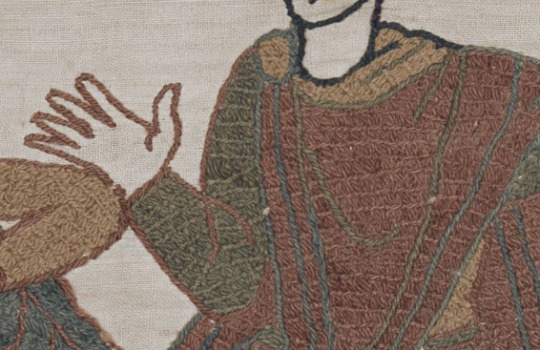
On the horns of each sheep, I experimented using surface couching, which was used in the 14th century. I chose to do this because at first pass, surface couching and laid work appear very similar, and at least to have similar results. At this time, I had finished the first sheep and not started the body on the second, so I was dissatisfied with the density of stitches in the white body of the sheep and was investigating new ways to increase my coverage. Upon finishing the horns, I determined that surface couching produces a very different overall effect to laid work, with denser stitches, but a much less economical use of thread.
After the horns and bodies were done, I added detail to the sheep in stem stitch to better define the fluffy wool. The folds in the fabric on several figures in the tapestry were done in what appears to be stem stitch and act as break points in many cases for the direction of the laid work. Due to the clarity of the folds and details, I had assumed they were applied after the fill color, but after having finished my piece I believe the internal details were applied prior to the fill color.
Following the completion of the sheep, I began embroidering the borders of the top section, the bottom line, and the borders of the diagonals in a soft orange color that reminded me of madder-dyed wool. This also seemed a close match to the color used on said borders in various sections of the tapestry. It was when I started working on the diagonals that I realized I was not, in fact, sewing a stem stitch as I’d thought, but sewing a split stitch. This realization explained several discrepancies I’d noticed in the visual texture of my linework and the linework in the tapestry. The diagonals are sewn in a stem stitch.
The next stage I sewed was the Ansteorran stars, with much wailing and gnashing of teeth. As my chalk lines kept rubbing off before I could get to the stars, I free handed the stars themselves. The first attempt to outline then fill the star like the sheep went sideways as the star did not come out with 5 even points. I eventually settled on sewing the 5 greater points with laid work and the 5 lesser points with satin stitch.
What would I change?
If I were to do this again, I would seek out a more densely woven linen and use either wool yarn as was used in the tapestry itself or the full 6 strands of my embroidery floss for visual density. I believe the fullness and volume of wool yarn will better mimic the appearance of the period piece. I would add more internal detail to break up the longer sections of satin stitch, and I would lay down the detail before adding the fill color. This seems to be the method used in the tapestry, shown in the detail from Scene 51 below.

In the transition from the neck to the spaces of the neck between sections of mane, and in the crook of the horse’s shoulder, the direction and angles of the laid work change. This seems to indicate that the internal detail (horse’s shoulder) was applied before the fill color, and that the particular direction of the laid work can be broken up to better fill a space.
Overall, I believe this project was a success. The goal was not perfect periodicity or reproduction, but to better make a useful piece of garb fit the ambiance designed for the casual (non-medievalist) patron. The patch covers the obtrusively modern machine embroidery and in doing so, helps create the Magic and the Dream for those visiting the Medieval Fair of Norman. I learned a new stitch that I have gone on to use in other hand embroidery projects for the security and economy of materials. I made several mistakes that gave me a better firsthand understanding of this historical piece and have improved and expanded my embroidery skills.
Navigate Bayeux Tapestry scene by scene https://www.bayeuxmuseum.com/en/the-bayeux-tapestry/discover-the-bayeux-tapestry/explore-online/
Bayeux Tapestry Meme Generator https://htck.github.io/bayeux/#!/
Bardcore https://en.wikipedia.org/wiki/Bardcore
Hobbitronics Hood Listing - https://www.hobbitronics.com/hoods.html
Referenced https://cottesimple.com/articles/medieval-embroidery-on-clothing/ for stitching methods
History of Medieval Tapestry Memes https://knowyourmeme.com/memes/medieval-tapestry-edits
Appendix
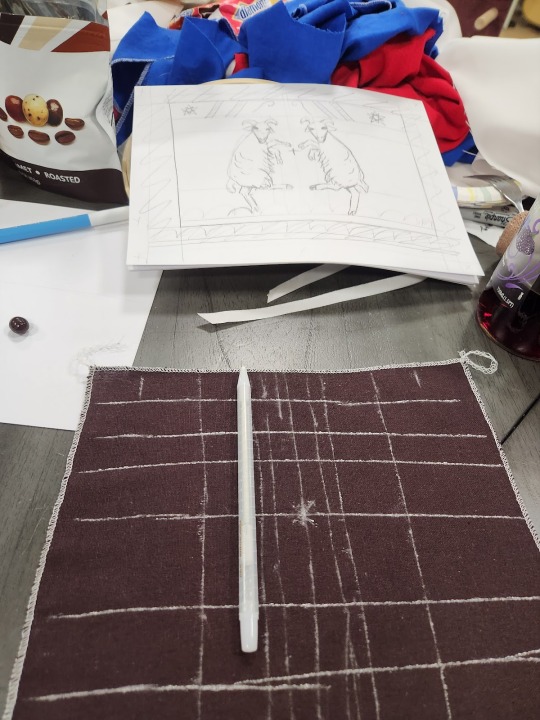
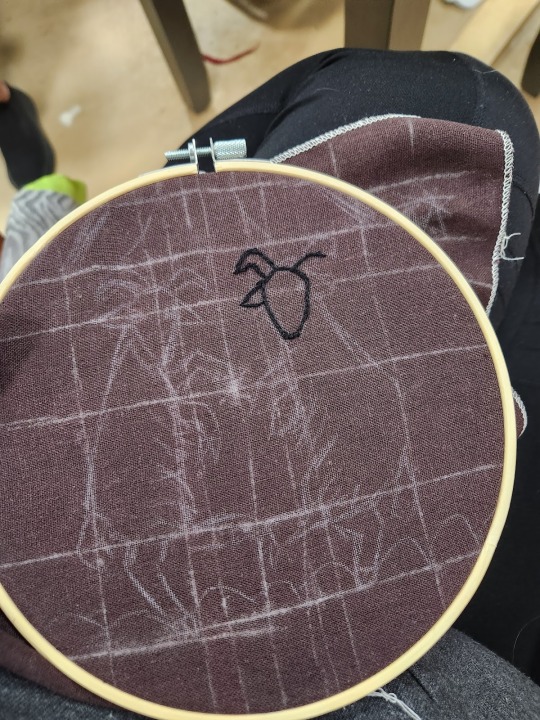
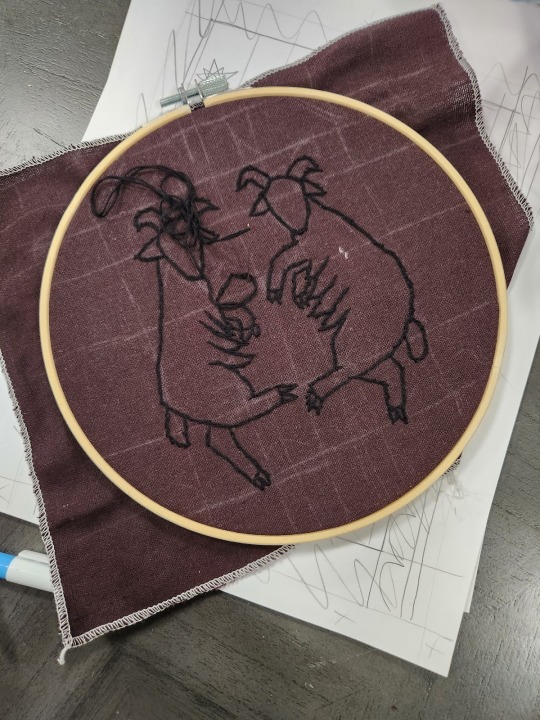
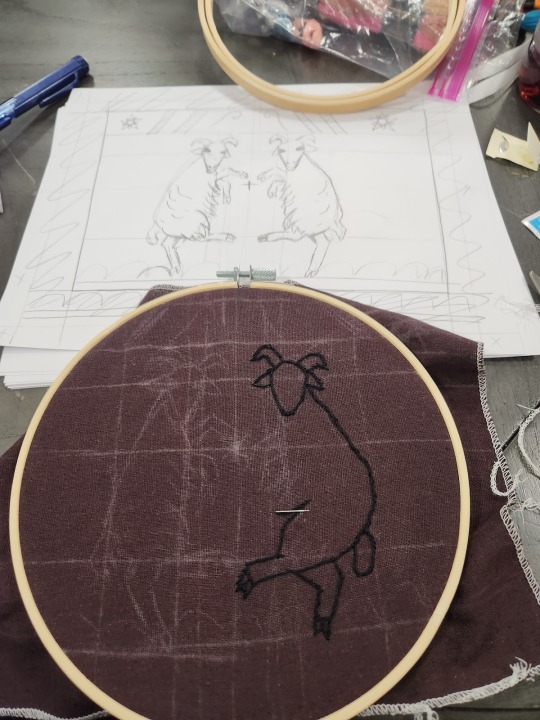

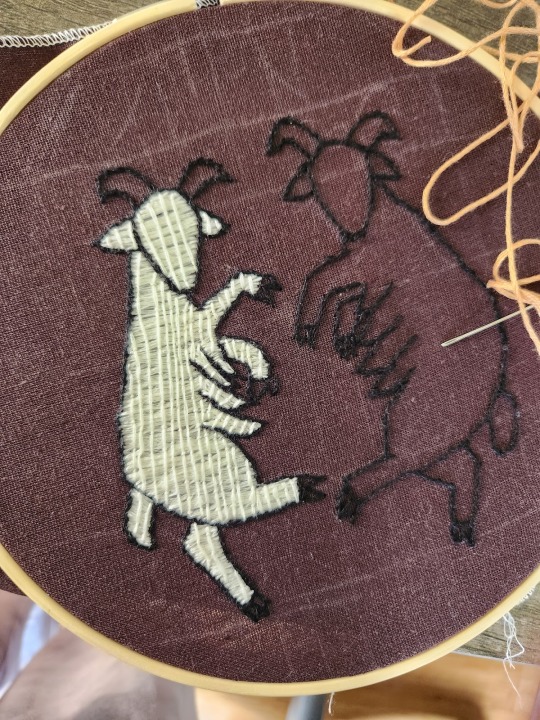

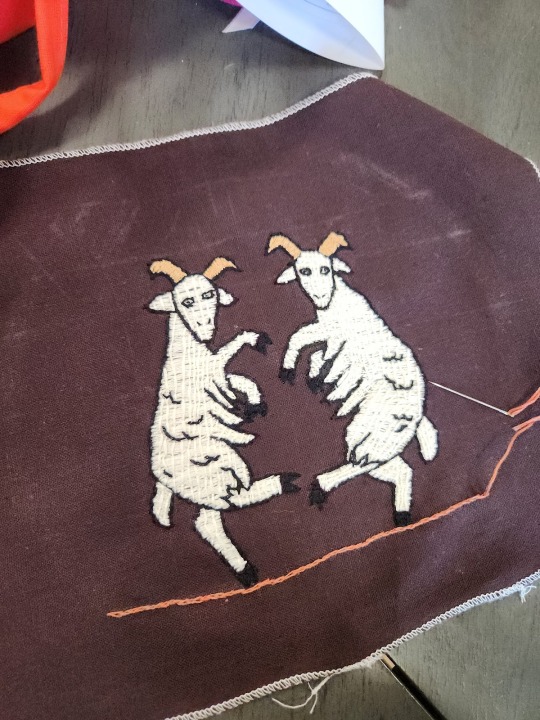
37 notes
·
View notes
Text
Sci-Fi Saturday: Things to Come

Week 18
Film(s): Things to Come (Dir. William Cameron Menzies, 1936, UK)
Viewing Format: Blu-Ray: Criterion Edition
Date Watched: 2021
Rationale for Inclusion:
Once upon a time in 2006, my partner and I took a formal science fiction film genre class during our year abroad at the University of East Anglia. Like Aelita: Queen of Mars (Аэли́та, Dir. Yakov Protazanov, 1924, USSR), Things to Come (Dir. William Cameron Menzies, 1936, UK) was on the syllabus. Also like Aelita, my partner and I remembered that it was interesting, and had great set pieces, but we did not like it enough to watch it again until this survey gave us the excuse.
Plus with a screenplay by H.G. Wells, adapted from his own 1933 book The Shape of Things to Come, the film would have been worth watching for that point alone.
Reactions:
Maybe I had forgotten, or maybe it did not hit the same way the last time I watched it in 2006, but I was taken aback by how ideologically fascist Things to Come becomes after its first act. Despite being a Fabian Society socialist, who was watching fascism and authoritarianism on the rise in Europe, Wells took the stance in The Shape of Things to Come and this film adaptation that the only way to unify the world, and bring about lasting peace and technological advancement, was under a benevolent dictatorship. Maybe being a man of the Victorian era, he simply thought imperialism and monarchy was fine when done the English way, despite it being frowned upon when anyone else did it.
Watching Things to Come in 2021, amid nationalism having a surge in popularity and being well aware of the history of colonialism and how much support Nazi ideology had in what would become the Allied countries in World War II, I was left with the impression that the film was pro-fascist.
The aesthetic of Wings Over the World being what they are, all militaristic and black, it is hard not to draw comparisons to the aesthetics of German Nazis or Italian Fascists. Given how explicitly anti-war Things to Come is leading up to John Cabal (Raymond Massey) flying up to Everytown, the audience is positioned to be as leery of this purposefully intimidating presence as the Boss (Ralph Richardson) is upon meeting the outsider. (Besides, dude looks like Boris Karloff.)
The Boss's leery defensiveness clashes with Cabal's self-assured pompousness, and the latter is taken prisoner. When the rest of his force comes to rescue Cabal, they rain down "The Gas of Peace" to incapacitate the populus, rescue their man, and take over Everytown. Given the mission of Wings Over the World, the taking of Everytown was inevitable, it was just a matter of how willingly the Boss and his community went.
A militaristic anti-war organization that uses something called "The Gas of Peace" is downright Orwellian (despite this film coming out 12 years before the publication of Animal Farm and 16 before Nineteen Eighty-Four) or it would be if it was meant satirically instead of sincerely. The heroic aviators and use of gas as vital technology were standards of the science fiction of this era, as we saw in F.P.1 (F.P.1 antwortet nicht, Dir. Karl Hartl, 1932, Germany), but the prior act of Things to Come being so explicitly anti-war makes it hard not to view a group that uses militarism to achieve their goals as anything but malevolent in the context of the filmic universe, even as the film narrative insists that Wings Over the World and their methods are positive and beneficial to humanity.
The third act of Things to Come, set a generation or two in the future from the second act, in 2036, shows glorious, gleaming subterranean cities that have been built under the leadership of Wings Over the World. Although this type of utopia's homogeneity is its own kind of concerning, the way the government is dismissive of the protestation of citizens that think technology is advancing too fast and the closing speech by Oswald Cabal (Massey again), the leader of the government and grandson of John Cabal, that humanity "must go on, conquest beyond conquest" only reinforces the second act's message that fascism is the necessary key to a successful society.
Did Wells and the filmmakers ever realize that what they were advocating in this film was the same ideology of the Axis powers that their country went to war against? Or was I right the first time when I wondered that authoritarian rule was fine for these Englishmen as long as it was the English doing the ruling?
Needless to say, I do not like Things to Come. I recognize the quality of the filmmaking, special effects and this film's impact on later genre films, but its politics are off putting. I find it equally off putting that most of the negative criticism towards this film is focused on its narrative structure and dull characters. Granted, those things were probably why I had not watched the film for 15 years. Plus, the third act absolutely drags in its pacing.
If I were to teach a science fiction cinema class, I likely would include Things to Come on the curriculum. It's a well made and interesting work of science fiction and has a lot of components to pick at and discuss; as evident from everything I wrote above. I just won't be throwing it on when I want some vintage sci-fi on a rainy afternoon, unlike most of the other films discussed in this survey thus far.
3 notes
·
View notes
Text

"But I don't have to let it win"
#season 2 my BELOVED#malevolent#malevolent podcast#arthur lester#john doe#john doe malevolent#jarthur#private eyes#this is a romantic jarthur blog btw#aesthetic#my edits
30 notes
·
View notes
Text
octopia dlc spoiler img below i just want to theorise about it,

THIS IS FUCKING ME UP BECAUSE IT DOESNT LOOK LIKE ANYTHING WE'VE SEEN IN MAIN GAME AS OF YET. all the robotic enemies in base game are distinctly made by solomon with the red/blue split aesthetic OR the more yellow/green/red varient that's associated with mother

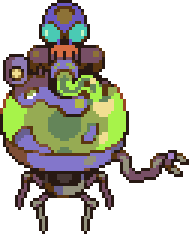

^ note the rust effect and much more haphazard way these creations look (mainly the exposed wires). OR of course the miasma enemies which still adheres to this colour palette v


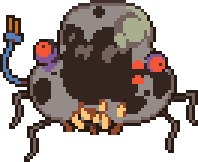
this new enemy is not only completely visually seperate with only body colour used and pure red eyes (i don't have images but imagine i put an image of the eyss found in the breeding facilities for reference) but is also much cleaner looking with a much slicker design, which leads me to think this is industrial rather than invented and produced by a single person.
this could also explain solomon's much more passive role in this version of the story as seen from official art and trailers, implying there's someone else whose taken on the mantle of producing these malevolent robotic creations to aid mother (or whoever is pulling the string this time around).
the fact its clearly based on a blimpig as well which we know from greenburg are ranch animals implies that it's been created by/for a farming company. i'm pretty confident that's the case considering the dlc focuses on john and sam moving to a farming town and taking up the mantle, reusing the main games theme of SOMETHING malevolent always lurking behind the scenes of a seemingly idyllic setting
trying to not get my hopes up too much but i'm SOOO excited to find out more about this
EDIT: WAIT I REALIZED THE MACHINE HAS ONE RED AND ONE YELLOW EYE WHICH IS CONSISTENT WITH MOTHER BUT NOT SOLOMON. THIS ADDS FURTHER QUESTIONS
4 notes
·
View notes